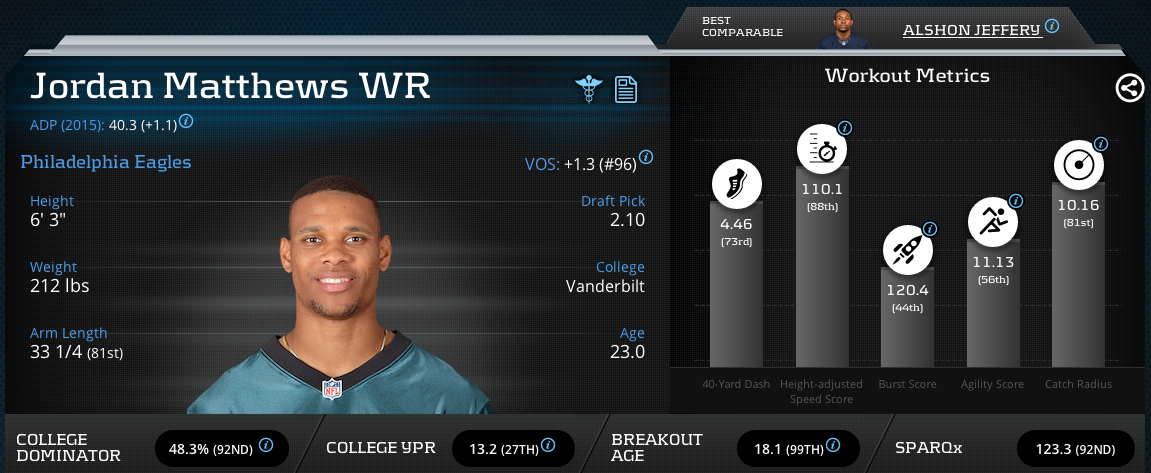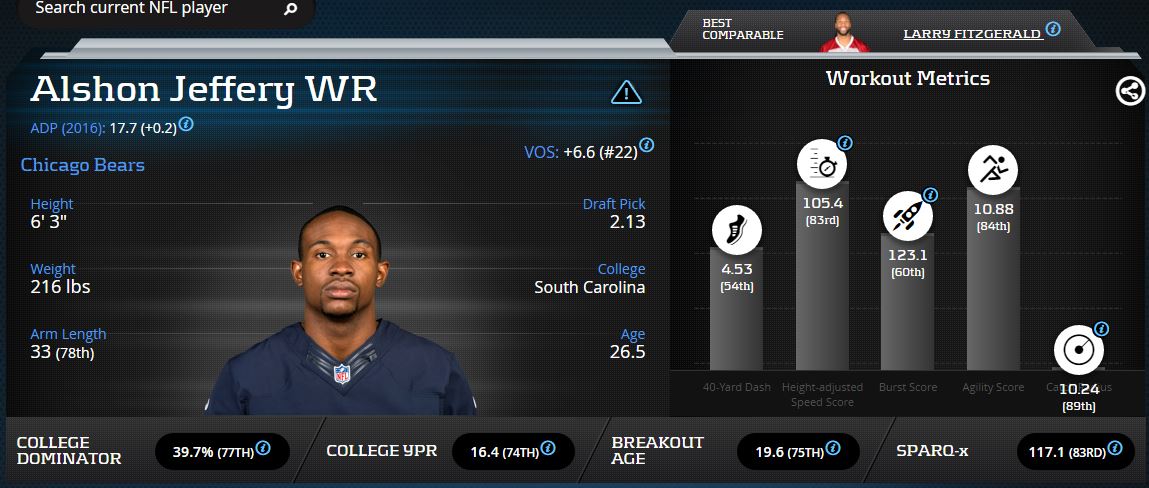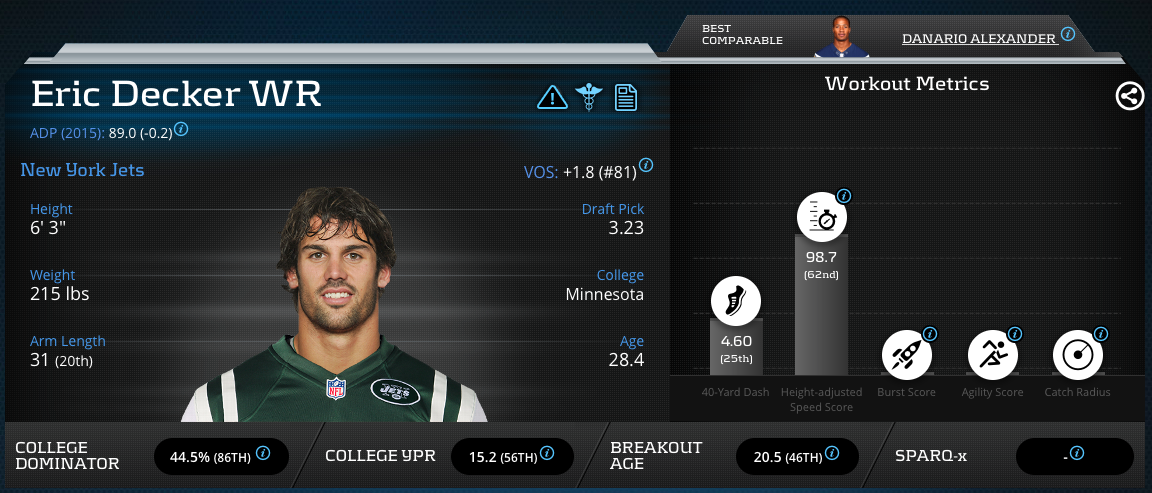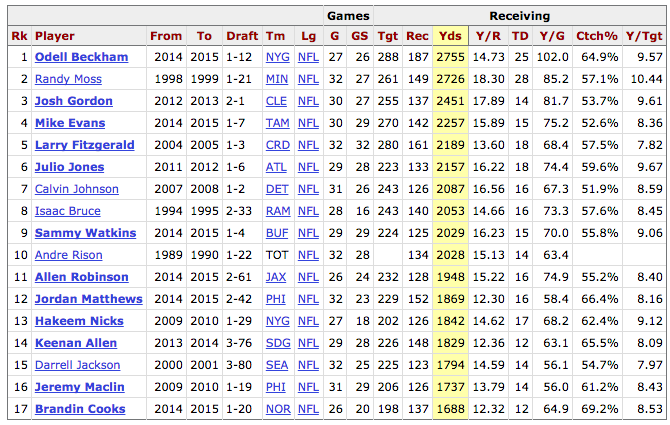It seems obvious that the most successful football players will usually be relatively athletic. While being the most athletic player on the field does not guarantee success, it certainly improves the odds that a player will be successful.
The PlayerProfiler Terms Glossary outlines two ways to evaluate how athletic a player is. The first, SPARQx – an approximation of Nike’s SPARQ (Speed, Power, Agility, Reaction and Quickness) rating, is a standardized test for athleticism. SPARQ input factors are 40-yard dash, vertical jump, 20-yard shuttle, and the power ball throw. Because Nikeʼs SPARQ formula is not public, we compared publicly available SPARQ scores to their related input factors, reverse-engineered an approximation of the SPARQ formula, and then applied the formula to each playerʼs workout metrics. For calculation purposes, power ball throw was converted into bench press so all input factors align with NFL Scouting Combine events.
The second method of evaluating athleticism is the Athleticism Score, which summarizes a player’s workout metrics and normalizes for size. It is derived by aggregating each player’s 40-yard dash, Burst Score, and Agility Score, and then factoring in a relevant measure of player size to ensure that big players receive a premium for speed, quickness and explosiveness. Running backs are afforded a BMI premium, while WRs and TEs are allotted a height and weight premium.
A hot debate on whether or not wide receivers will provide fantasy value is whether or not they can play outside, and not just in the slot. One way to find out whether or not a receiver can line up outside is to look at his athleticism, and there is one receiver we can focus on at the center of this debate.
Slot or Outside Receiver?
The Philadelphia Eagles boast third year wide receiver, Jordan Matthews, as one of their top pass catchers. Matthews is constantly at the center of the slot versus outside wide receiver debate. Should he be in the slot, outside, or everywhere as a wide receiver, and just how much can this matter for him?
Jordan Matthews does not profile as just some average slot receiver based on his athleticism. He stands 6 foot 3 inches tall and measures in at 216 pounds. Additionally, his 4.46 (75th-percentile) 40-Yard Dash, 110.1 (89th-percentile) Height-adjusted Speed Score, and 11.13 (58th-percentile) Agility Score all contribute to his 91st-percentile SPARQ-x Score. His only sub 50-percentile athletic score is his 120.4 (45th-percentile) Burst Score. Overall, Matthews stellar athletic profile provides him with a 10.18 (82nd-percentile) Catch Radius.
Jordan Matthews athletically profiles as the prototypical Split End, and some of his top athletic comparisons are just that as well. Matthews most resembles Alshon Jeffery according to our algorithms. When looking through Jeffery’s comparisons, other notable receivers like A.J. Green, Larry Fitzgerald, and Jordy Nelson all appear. If anything, Matthews has the prerequisite athleticism to excel at split end on the outside based on the wide receiver athletic prototype he has.
Third Year Ascension
Even if Jordan Matthews does not become a full time split end for the Eagles this year, he deserves respect among the fantasy and real football communities. Another receiver who Matthews compares to, and whom he has been used most like to date, is Eric Decker, who, like Matthews, stands 6 foot 3 inches tall, and weighs 215 pounds.
Jordan Matthews compares to Eric Decker in more ways than just size and where they lineup. Although college statistics are predictors for when players enter the league, Matthews is an upgraded Decker when it comes to college statistics. Matthews posted a 48.3 percent (93rd percentile) College Dominator Rating with an 18.1 (100th percentile) Breakout Age; comparatively, Decker posted a 44.5 (87th percentile) College Dominator Rating with a 20.5 (49th percentile) Breakout Age. Nobody has broken out at an age younger than Matthews, and almost nobody has a stronger College Dominator Rating than he; as a prospect, it is tough to find one better than Matthews.
Additionally, at the next level, Jordan Matthews and Eric Decker still compare to each other. To emphasize their similar roles, both produced 7.8 yards per target in 2015; Decker produced 12.8 yards per reception while Matthews posted 11.7 yards per reception. Both players had top 15 Red Zone Target Shares (Matthews 13th, and Decker 1st), top 36 Production Premiums (Matthews 27th, and Decker 36th), and top 36 Target Premiums (Matthews 31st, and Decker 10th). All these similarities led to Matthews producing 85 receptions, 997 yards, and 8 touchdowns on only 128 targets; Decker hauled in 80 receptions, 1,027 yards, and 12 touchdowns on 132 targets.
Jordan Matthews and Eric Decker are eerily similar receivers, and Matthews is only looking up going into year three. His Snap Share, Target Share, and Hog Rate steadily improved from year one to year two in the league, and we should expect the same for year three. Through two years, Matthews has 152 receptions, 1,869 receiving yards, and 16 touchdowns on 229 targets. Using Pro Football Reference, only 17 wide receivers have produced at least 120 receptions for 1,600 yards and 12 touchdowns in their first two years by the age of 23, and the list has quite the names. Get your hands on Matthews now before his ascension takes him even higher than he already is!






